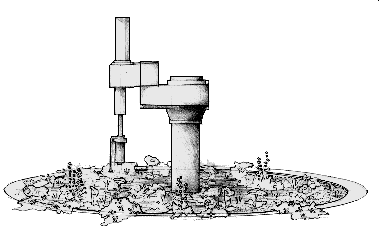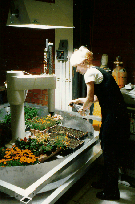|

The Telegarden (1995-2004)
"Il faut cultiver notre jardin." Voltaire
Co-directors: Ken Goldberg and Joseph Santarromana
Project team: George Bekey, Steven Gentner, Rosemary Morris
Carl Sutter, Jeff Wiegley
Ars Electronica team: Erich Berger, Gerold Hofstadler, Thomas Steindl,
Gerfried Stocker
Archivist: Hannes Mayer
The Telegarden:
art installation that allows web users to view and interact
with a remote garden filled with living plants. Members can plant,
water, and monitor the progress of seedlings via the tender movements
of an industrial robot arm.
New! (Dec 2013): STL model of the Telegarden for 3D printers
New artworks and projects.

The Telegarden was developed at the University of Southern California
and went online in June 1995. In its first year, over 9000 members
helped cultivate. In September 1996, the Telegarden was moved to the
lobby of the Ars Electronica Center in Austria, where it remained
online until it was decommisioned in August 2004. The Alternate Village Square chatroom
remains available with archival photos and other information.
``In linking their garden to the World Wide Web and creating an
intuitive interface for the control of the arm and camera, the artists
transformed what most would consider a fit of over-engineering into a
subtle rumination on the nature of the Commons.''
-- Peter Lunenfeld, Flash Art , XXIX, 187, March 1996.

``The Telegarden creates a physical garden as an environment to stage
social interaction and community in virtual space. The Telegarden is
a metaphor for the care and feeding of the delicate social ecology of
the net.''
-- Randall Packer, San Jose Museum of Art, April 1998.
The Telegarden went online in June of 1995 and has been online
continuously for seven years. It currently is located in the Ars
Electonica Museum in Austria. Anyone can view the garden as a guest;
the rights to plant and water are granted to those who agree to share
their email addresses with other members of the cooperative. Activity
is recorded in logs so that the cooperative can be self-governing.
``...For the experienced gardener, the TeleGarden offers
a search for the sould of gardening. Sowing a
single, unseen and untouched seed thousands of miles away might seem
mechanical, but it engenders a Zen-like appreciation for the
fundamental act of growing. Though drained of sensory cues, planting
that distant seed still stirs anticipation, protectiveness, and
nurturing. The unmistakable vibration of the garden pulses and pulls,
even through a modem.''
-- Warren Schultz, Garden Design, Dec/January
1996.
``The Neolithic Revolution began sometime around 8000 B.C. when
humans made their first successful attempts to domesticate animals and
food grains.... Having learned how to assure their food supply by their
own efforts, they settled down in permanent village communities.''
-- H. W. Janson, The History of Art.
``For its engaging use of the Web, bringing together an international
group of strangers to explore and nourish nature in sharing a common
garden, the First Prize goes to the Telegarden as a
powerful metaphor for virtual communities.''
-- Jury, Festival of Independent Visual Arts (FIVA), 1995.
The Telegarden was featured on: CNN, CNet, NHK TV, Canal+ TV, NPR
Radio, The Chronicle of Higher Education, New York Times, London
Times, Wall Street Journal, Popular Science, Byte, FlashArt, and WiRed
as well in books including Taschen's New Media Art, Thames and
Hudson's Internet Art, Thames and Hudson's Digital Art, and UC Press:
The Not-So-Still Life: a century of california painting and
sculpture.
For a sociological study of community in the Telegarden:
"Virtual Community in a Telepresence Environment," Margaret
L. McLaughlin, Kerry K. Osborne, and Nicole B. Ellison, in S. Jones
(Ed.), Virtual Culture (pp. 146-168). London: Sage Publication,
Inc. 1997.
|


